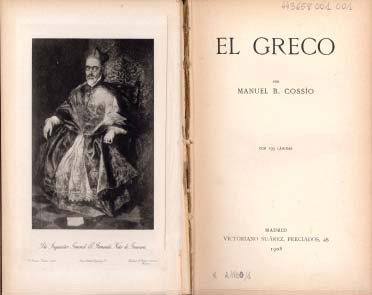

 Anónimo, El entierro del señor de Orgaz (copia del Greco), hacia 1625. Óleo sobre lienzo, Museo Nacional del Prado, Madrid.
Anónimo, El entierro del señor de Orgaz (copia del Greco), hacia 1625. Óleo sobre lienzo, Museo Nacional del Prado, Madrid.
 Cubierta del primer volumen del libro de Manuel B. Cossío El Greco, Madrid, Victoriano Suárez, 1908. Residencia de Estudiantes, Madrid.
Cubierta del primer volumen del libro de Manuel B. Cossío El Greco, Madrid, Victoriano Suárez, 1908. Residencia de Estudiantes, Madrid.
«The works of art are born from the wide subconscious abyss in which the soul roams».
«El Greco did not treat with greater love or repeated with such persistence any saint as he did with Saint Francis».
«The Quixote put an end to the artful and discordant chivalric romances, and ennobled the simple and humoristic narration of customs; the The Burial of the Count of Orgaz was the first and most obvious of his protest against the manierist compositions; El Greco influenced Velazquez with his perpetual disdain against every possible artifice».
The Burial of the Count of Orgaz: «El Greco assimilates a mystic style which is naturalista and ascetic at the same time».
Manuel B. Cossío
The first great monography about the Toledan painter was published by Manuel B. Cossío in 1908. It serves as a fundamental work without which the large process that took El Greco to be an essential figure, not only for the European art of his time but also for canonical occidental painting, could not be understood.
In his book, Cossío offers a chronological overview of the most significant events in the life of the painter. He also makes a classification of El Greco’s paintings depending on their style and makes a critical evaluation of his work as an artist. He compiled and interpreted everything that had been published so far and traced an outline of the stylistic evolution of the painter. The more than five hundred pictures included constitute the first reasoned catalogue on this painter. Apart from that, Cossío also incorporates new information acquired during his archive research on a wide variety of works by El Greco. For instance, the first reference made to the Allegory of the Camaldolilte Order can be found in this catalogue.
El Greco and its numerous reprints became for decades the referential work on the Toledan painter thanks to Cossío’s effort.